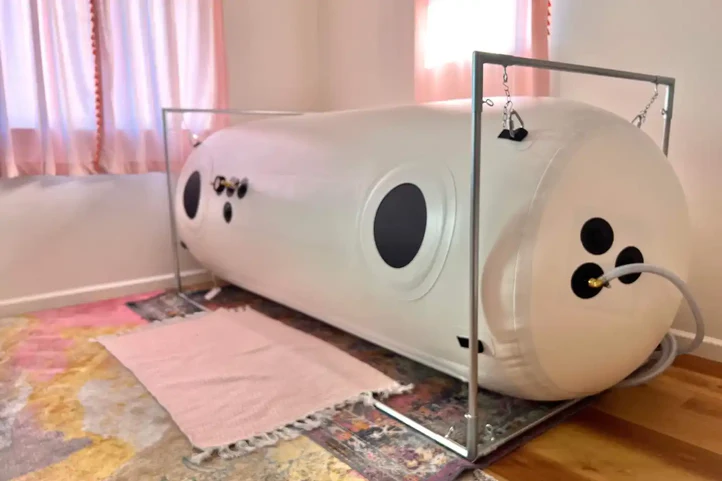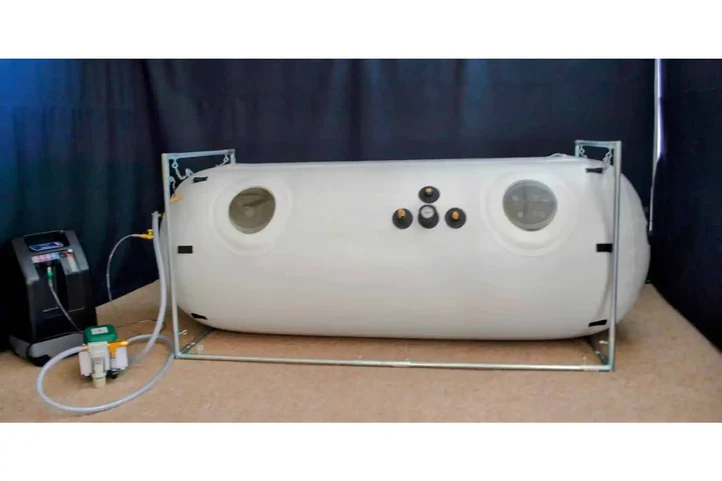The Mechanics of Hyperbaric Chambers
Hyperbaric chambers are special rooms or devices that allow you to breathe air at increased pressure levels. By increasing the air pressure, these chambers help your body absorb and distribute higher oxygen levels. Oxygen, as we all know, is like fuel for our bodies – our cells must function properly.
So, how do hyperbaric chambers achieve this increased pressure? Well, imagine a balloon that you’re filling with air. As you add more air, the balloon expands, right? Well, hyperbaric chambers work a bit like that. They use compressed air or pure oxygen to pressurize the chamber. This increase in pressure forces more oxygen into your bloodstream, allowing it to reach areas in your body that need it the most.
Now, what’s the difference between hyperbaric pressure chambers and hyperbaric chambers? Well, the answer is quite simple. Hyperbaric pressure chambers are more specialized and can reach exceptionally high pressures. They’re primarily used for treatments that require intense pressure, such as deep-sea diving injuries or carbon monoxide poisoning. On the other hand, regular hyperbaric chambers provide a less extreme but beneficial increase in pressure for various medical conditions.

Pressure Levels in Hyperbaric Chambers
Hyperbaric chambers such as summit to sea hyperbaric chamber are known for their ability to create an environment where pressure levels can be adjusted. Typically, these chambers are pressurized to levels two to three times higher than atmospheric pressure. Simply put, while breathing in a hyperbaric chamber, your lungs would encounter more oxygen molecules due to the increased pressure. This heightened oxygen concentration can remarkably impact various conditions, from infections to tissue damage.
Understanding the pressure measurements in hyperbaric chambers may help you grasp their significance. Absolute pressure is measured in pounds per square inch absolute (PSIA). Comparatively, atmospheric pressure at sea level is around 14.7 PSIA. When inside a hyperbaric chamber, the pressure may rise to around 30-45 PSIA. This elevation affects the air pressure within your body, including tissues, fluids, and even the gases dissolved in your bloodstream.
The rationale behind these increased pressure levels lies in the body’s ability to absorb more oxygen efficiently. By providing an oxygen-rich environment, hyperbaric chambers enable healing and encourage the body’s natural processes to promote recovery. Whether used to treat wounds, reduce inflammation, or even hasten the effects of radiation therapy, the careful regulation of pressure within hyperbaric chambers offers an alternate and promising avenue for medical intervention.
Standard Pressure Settings
To begin with, let’s discuss the terms and units used to measure pressure in hyperbaric oxygen therapy. The most common unit is atmosphere absolute, or ATA for short. At sea level, where the air around us feels normal, we live in one absolute atmosphere (1 ATA).
Now, here’s where it gets interesting. Hyperbaric therapy increases the pressure beyond what we experience at sea level. That’s why it’s called hyperbaric pressure! Hyperbaric oxygen therapy exposes people to pressures greater than 1 ATA.
Knowing there are different standard pressure settings in hyperbaric chambers is crucial. For example, you might come across terms like 1.5 ATA, 2 ATA, or even higher. These numbers refer to the pressure inside the chamber and indicate how much higher it is than at sea level.
Understanding standard pressure settings is vital because it helps professionals tailor therapy to people’s needs. So, the next time you hear someone mention hyperbaric pressure or terms like 2 ATA, you’ll understand what they mean without getting overwhelmed.
Factors Influencing Pressure Levels
Firstly, the ambient pressure in the hyperbaric chamber plays a crucial role. Ambient pressure refers to the pressure of the surrounding environment. In HBOT, the chamber is pressurized to levels higher than the atmospheric pressure we experience at sea level. This increased pressure allows greater oxygen absorption into the bloodstream, benefiting healing and recovery.
Another significant factor is the gas concentration inside the hyperbaric chamber. Typically, pure oxygen is used for HBOT because it provides the highest concentration of oxygen available. This increased concentration of oxygen further enhances the therapeutic effects of the treatment by increasing the amount of oxygen that can be dissolved in the blood.
Additionally, the rate at which the chamber is pressurized and depressurized also impacts the treatment session. Gradual changes in pressure help minimize any discomfort or potential side effects and ensure a safe and effective treatment session.
Factors Influencing Pressure Levels
Firstly, let’s talk about hyperbaric pressure. This is the increased air pressure inside the chamber that you will experience during the therapy. The pressure is measured in units called atmospheres absolute (ATA). To put it simply, one ATA is equal to the air pressure at sea level. The pressure can gradually increase to a specific ATA level during your session based on your medical condition and the desired therapeutic outcome.
The level of discomfort you might experience depends on the rate at which the pressure changes. Rapid pressurization can lead to uncomfortable sensations in your ears, similar to what you might feel during takeoff and landing on a plane. However, this discomfort can be alleviated by equalizing the pressure in your ears using techniques like swallowing or yawning.
Once the desired pressure level is reached, you will stay there for a certain period, typically between 60 to 120 minutes. This allows your body to absorb more oxygen, positively affecting your health.
The chamber will be slowly de-pressurized when the therapy session ends to restore the pressure. This process is equally important, as rapid de-pressurization can lead to the formation of air bubbles in your body, potentially causing a condition known as decompression sickness or “the bends.” Hence, a gradual return to normal pressure is crucial for your safety.

Benefits of Specific Pressure Levels
- Mild Hyperbaric Therapy: Mild hyperbaric therapy involves experiencing increased atmospheric pressure inside a chamber set at a lower pressure than traditional hyperbaric chambers. This gentle approach has improved oxygen delivery to your body’s tissues, promoting accelerated healing, enhanced athletic performance, and reduced inflammation. Numerous individuals have found mild hyperbaric therapy to be beneficial for conditions such as chronic fatigue syndrome, fibromyalgia, and post-concussion symptoms. Additionally, it may promote deep relaxation and provide a sense of general well-being.
- Hyperbaric Oxygen Therapy (HBOT): Hyperbaric oxygen therapy, also known as HBOT, involves exposing the body to high levels of pure oxygen in a pressurized chamber. This treatment can greatly enhance the oxygen supply to all organs and tissues throughout your body, driving positive changes at the cellular level. HBOT has been proven effective in treating various medical conditions, including decompression sickness, non-healing wounds, radiation injury, and carbon monoxide poisoning. It can also assist in reducing inflammation, boosting the immune system, and facilitating recovery after surgery or injury.
Health Benefits of Hyperbaric Oxygen Therapy (HBOT)
First and foremost, HBOT involves breathing pure oxygen in a pressurized chamber. This higher oxygen concentration has many positive effects on your health. One of the most remarkable benefits is stimulating new skin, blood vessels, and connective tissues. If you have an injury or wound, HBOT can help your body rebuild and repair damaged tissues!
Speaking of wounds, HBOT is especially effective in healing chronic wounds. These wounds have difficulty healing independently due to poor blood flow or other underlying conditions. By increasing the amount of oxygen delivered to the tissues, HBOT boosts healing and promotes faster closure of chronic wounds.
Pressure Levels and Healing Process
Hyperbaric pressure is the higher-than-normal pressure inside the chamber, achieved by pumping in more air or oxygen. This increased pressure significantly impacts the healing process. When your body is under this pressure, it can absorb more oxygen, essential for healing damaged tissues.
Different units are used to measure hyperbaric pressure. One common unit is millimeters of mercury (mmHg), similar to the pressure readings on a regular blood pressure monitor. Another unit is pounds per square inch (psi), a measure of pressure commonly used in engineering and industry. In diving, especially when measuring underwater pressure, feet of seawater (fsw) or meters of seawater (MSW) are used. Lastly, atmospheric pressure is measured in the atmosphere’s absolute (ATA).


Recent Comments